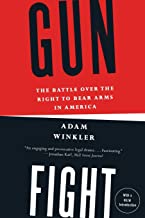
Gunfight: The Battle Over the Right to Bear Arms in America has, interestingly, been accused of being both NRA propaganda and wildly anti-gun. The varying reactions to this book suggest that author Adam Winkler has at least tried to take a balanced approach in his discussion.
This book gives an excellent panorama of the gun control debate, mostly centered on the D.C. v. Heller case. And the author’s conclusion seems to be somewhere near the middle of the range of proposed solutions to gun violence.
However, this book is not a perfect or comprehensive source of information. It’s best used as a piece of a larger reading list. But, it’s certainly worth reading. Here’s why, and what to expect.
Decent History
Winkler spends a fair amount of time on the history of gun control. This history is where this book gets the most criticism for taking an anti-gun stance.
He details the history of gun control from before the inception of the United States to near the present day (it was published in 2013). He cites local gun control laws implemented in the Old West and subsequent gun control measures that were put in place during the 1920s, 1960s, and 1980s.
The author’s position seems to be that gun control measures have been put in place before, and nothing bad happened, so why worry? We still have the individual right to keep and bear arms.
But it’s up to the reader to decide whether or not the author’s sources and analysis support his conclusions. Also, staunch supporters of the “shall not be infringed” part of the Second Amendment will likely disagree with a number of his opinions.
Conclusions aside, from a purely historical standpoint, there are other books that evaluate a much longer timeline for those who are interested in the history of guns and gun control.
Individual Rights
From the outset of the book, Winkler makes clear that he recognizes the Second Amendment as an individual right. This is a significant distinction between this book and many left-leaning pieces of literature. This also tends to be the main sticking point for those who have branded this book as NRA propaganda.
However, the book certainly doesn’t meet the usual standards for pro-gun literature. The author makes the case for certain gun control measures, from the standpoint that the Second Amendment secures limited individual rights. The book doesn’t toe the line of the gun control lobby, taking a more compromising stance.
Overall, Winkler takes a problem solving approach, with the assumption that there must be a solution. He hasn’t written a pure justification of one side of the argument or the other. He presents a counterpoint to nearly every position he discusses. He details the history and facts surrounding the problem of gun violence, and attempts to arrive at a solution.
This is not a book suited to those who are reading solely for the purpose of bolstering a certain position, whichever side they are on.
Extensive Sources
Obviously, any discussion of the Second Amendment without multiple references would never be taken seriously. The good news here is that Winkler collected a lot of information. In fact, a significant portion of the pages in this book are dedicated to the sources section.
However, one of the chief criticisms that can be levied against this book is the variable quality of his sources. Winkler seems to have taken any and all data involving guns for source material. He captures many very good original sources, but he also uses some questionable ones. For instance, Winkler cites a “study” underwritten by Michael Bloomberg which concluded that 63% of private sellers sold guns to buyers who had admitted that they “probably couldn’t pass a background check.”
However, this data was collected by a couple of people whom Bloomberg sent to gun shows in just three states, asking only 30 sellers. The methodology hardly qualifies as research. But Winkler’s wide net picked this up as somehow relevant.
Also, there’s been scrutiny over Winkler’s assessment of certain information. Winkler cites Clayton Cramer, who has studied and written extensively about concealed carry laws. Cramer is an excellent source. However, students of Cramer may decide that Winkler’s interpretation of Cramer’s work is flawed.
Even with these imperfections, it’s clear that Winkler put in the time and effort to ensure that he offers very few, if any, unsupported opinions. Those looking for a book that provides plenty of research and further reading to chew on will appreciate the range of sources cited in this book.
Plenty of Anecdotes
The most universal criticism of this book is that it can be hard to follow at points. Winkler often shifts forward and back in the timeline. He focuses on the seminal case D.C. vs Heller for short periods before shifting focus to a separate story or anecdote to drive a point home.
You have to pay attention to stay oriented. Occasionally, the anecdote or story Winkler uses to demonstrate a point takes a while, and it takes some mental effort to take his point back to D.C. vs Heller.
However, his writing style keeps all the legal talk and law jargon from getting stale. You won’t get bored. But you may need to reference pages you’ve already read to avoid confusion.
Is Gunfight for you?
If you’re looking for a laundry list of pro-gun or anti-gun talking points, this book isn’t for you.
If you’d like to read a deep examination of the material interpreting the Second Amendment leading to one man’s conclusions about how to practice it and what to do to retain our right to bear arms in the 21st century, you may enjoy it. Whether or not you agree with Winkler is entirely up to you.
.
.

—Jay Chambers is a Texas archer, shooter, survivalist and business owner at Minuteman Review. He believes in free speech, resiliency and self-sufficiency in an increasingly unpredictable world.
